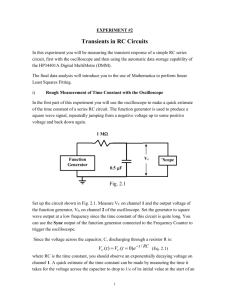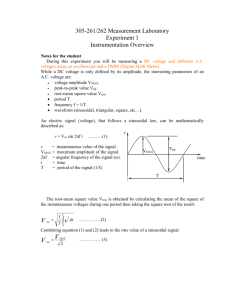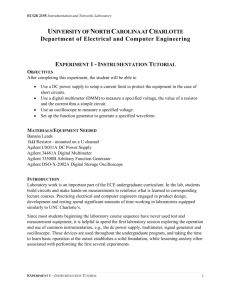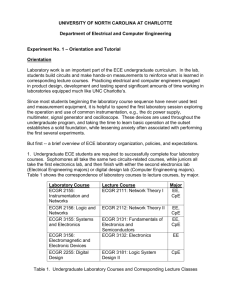Lab 3: Equivalent Resistance
advertisement
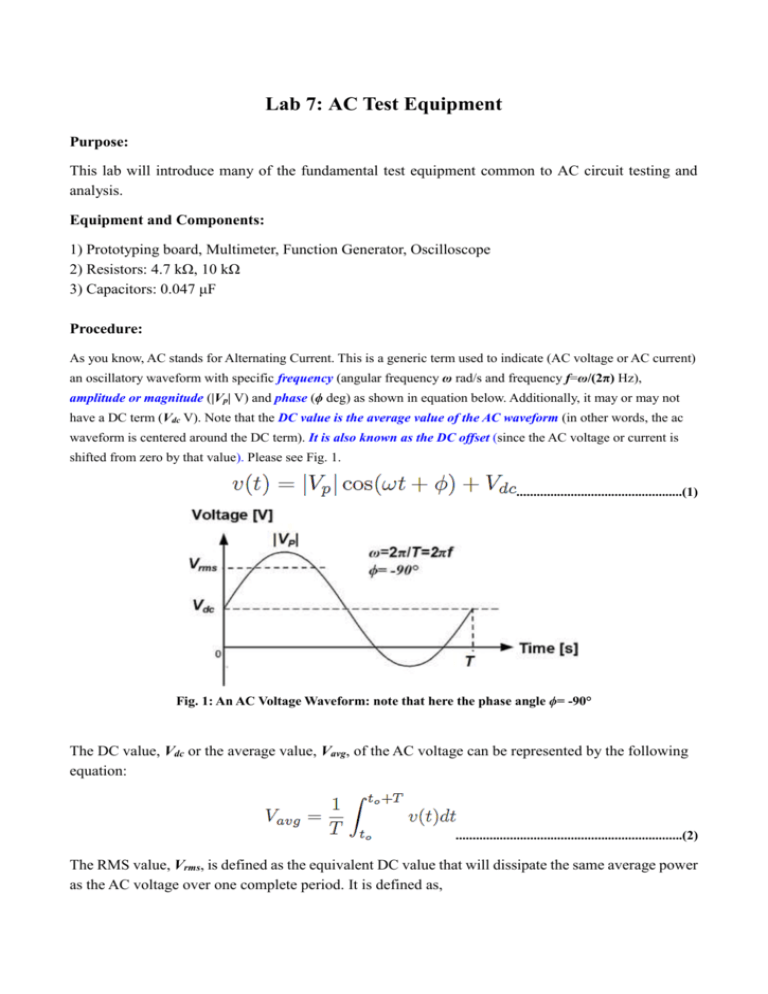
Lab 7: AC Test Equipment Purpose: This lab will introduce many of the fundamental test equipment common to AC circuit testing and analysis. Equipment and Components: 1) Prototyping board, Multimeter, Function Generator, Oscilloscope 2) Resistors: 4.7 kΩ, 10 kΩ 3) Capacitors: 0.047 μF Procedure: As you know, AC stands for Alternating Current. This is a generic term used to indicate (AC voltage or AC current) an oscillatory waveform with specific frequency (angular frequency ω rad/s and frequency f=ω/(2π) Hz), amplitude or magnitude (|Vp| V) and phase (ϕ deg) as shown in equation below. Additionally, it may or may not have a DC term (Vdc V). Note that the DC value is the average value of the AC waveform (in other words, the ac waveform is centered around the DC term). It is also known as the DC offset (since the AC voltage or current is shifted from zero by that value). Please see Fig. 1. .................................................(1) Fig. 1: An AC Voltage Waveform: note that here the phase angle ϕ= -90° The DC value, Vdc or the average value, Vavg, of the AC voltage can be represented by the following equation: ...................................................................(2) The RMS value, Vrms, is defined as the equivalent DC value that will dissipate the same average power as the AC voltage over one complete period. It is defined as, ...................................................................(3) Vrms is normally calculated as 0.707 |Vp|. For example, if |Vp| = 2 V and Vdc=0 V,then Vrms=(0.707)(2 )= 1.414 V. If |Vp| = 2 V and Vdc=1 V,then Vrms=(0.707)(2 )+1= 2.414 V. Please refer to the Appendix for a brief explanation on function generator, oscilloscope, and multimeter. 1. Experiment: Voltage Divider Construct a voltage divider with the 4.7 kΩand the 10 kΩresistors in series with the function generator as shown in Fig. 2. Set the function generator to produce a 1 kHz sine wave with a peak voltage (amplitude) of 1 V. Fig. 2: Voltage divider circuit with AC voltage source: set amplitude=1V, frequency=1 kHz, DC offset=0 V, phase = 0° 1) Measure and record the voltage drop across the 4.7 kΩ and 10 kΩ resistor with the multimeter. Use both the DC and AC voltage settings. Display these values in a table and verify that KVL (Kirchoff’s Voltage Law) is still valid. Note that the AC voltage setting on the multimeter gives the rms value. 2) Now use the oscilloscope and measure the voltage drop across the 4.7 kΩ and 10 kΩ. Sketch the resulting waveforms. Do the waveforms agree with KVL? Note1: You may find it difficult to display the waveform across 4.7 kΩ resistor using one probe. Use two probes (make sure to ground them) and measure voltages on the two ends of 4.7 kΩ resistor. Next use the Math function on the o-scope to find the voltage drop (difference). Note2: Adjust the time/div, volts/div, trigger, and positions to get the best reading and record the effects of each adjustment. Remember the #/div referrers to the large divisions seen on the screen. 3) Calculate the ratio between the Peak voltages measured with the oscilloscope and the RMS values measured with the multimeter for both 4.7 kΩ and 10 kΩ. The ratio should be close to √2=1.41. 4) Using the oscilloscope, measure the period and the frequency (1/T) of the voltage waveform dropping across the 4.7 kΩ and 10 kΩ resistor (the frequency should be 1 kHz). Op-Amp Circuit Now, construct the circuit shown in Fig. 3 using a LM741 or equivalent Op-Amp and + /- 15 V power supplies. 5) Apply a 1 Vamp, 1 kHz sinusoidal signal. Using Channel 1 of the oscilloscope to monitor the input voltage and Channel 2 to monitor the output, sketch the resulting display. Identify what mathematical expression the circuit implements. Hint: Pay close attention to the phase variation between the input and output signals. Also take a note of the output amplitude level. Fig. 2: Op-amp circuit with AC voltage source: set amplitude=1V, frequency=1 kHz, DC offset=0 V, phase = 0°, probe input and output voltages and describe what function the circuit performs. 2. Conclusion Discuss the use of multimeter vs an oscilloscope. Note any observations you made during the experiment and/or other key concepts that you learned while performing the measurements. Appendix Function Generator: Not all signals are constant (DC sources), many laboratories have function generators that are capable of producing various types of alternating current (AC) voltage signals. The most common signals are sinusoidal, square, triangle, and ramp type voltage sources. Many function generators also provide control over the peak voltage, frequency, and duty cycle of the generated waveform. High quality signal generators also enable the addition of a DC source in series with the AC component to produce a DC Offset. In many cases the circuit under test will actually load the generator and distorts the signals, making it difficult for a graphical analyzers / oscilloscopes to lock on to a repeating part of the waveform. To aid in viewing of these waveforms, high end generators also provide a sync signal, a TTL (0-5V) pulse type signal that is synchronized to the “start” of the waveform. This trigger signal can then be connected direct to the triggering part of the oscilloscope to provide repeatable sweeps. Oscilloscope: Oscilloscopes are graphical volt-meters that display variations in voltage with respect to time. Many oscilloscopes are also capable of displaying multiple waveforms as well as mathematical combinations of the sensed signals. The most common controls on the oscilloscope are the Vertical (Volts/Division), Horizontal (Seconds/Division), and the Trigger. The vertical control can be used to adjust the display scale of the vertical deviations. This is helpful when viewing signals near the noise floor or strong signals. The horizontal control is used to vary the temporal resolution seen on the screen. The Trigger is used to identify when the oscilloscope should begin recording/displaying the signal and at what interval. Two very important issues to remember when operating an oscilloscope are: a) Make sure the probes are calibrated using the internal calibration signal. To do this, connect the probe to the internal square wave source and then adjust the shunt capacitance on the probe until the rising edge of the square wave is as sharp as possible without overshoot. b) Many probe have a built in 10x amplification factor. Make sure that the multiplying factor presented by the probe matches what the oscilloscope is expecting to see. Otherwise all of your values will be off. If you desire additional information on how to use an Oscilloscope, google “XYZ’s of Oscilloscopes”. Multimeter: Mulitmeters can also be used to measure AC signals. However when using a multimeter set for AC readings, they are only able to read DC equivalent or RMS value. Some multimeters also have options that enable the DC setting to measure the DC offset, instantaneous value, and a peak hold feature that can be used to find the peak value.






